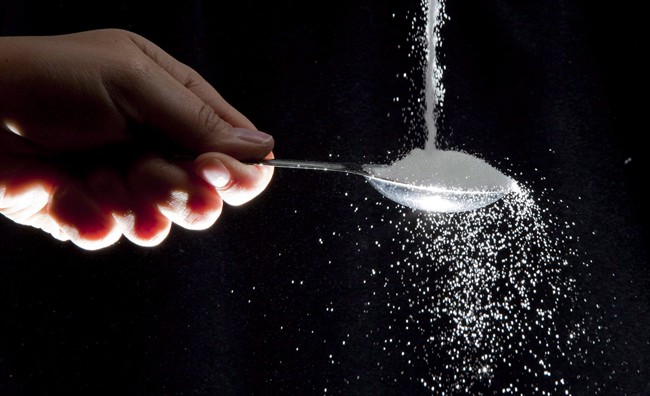TORONTO – Canadians need to monitor their daily intake of added sugar – found in honey, syrups, fruit juice and in packaged foods – for better cardiovascular health, the Heart and Stroke Foundation is warning in a new position statement.

Canadians should be aiming for a maximum limit of sugar that’s less than 10 per cent of their day’s calories. Ideally, it should be less than five per cent, the organization is suggesting.
The Heart and Stroke Foundation is the first in the country to provide concrete recommendations on added sugar. Its recommendations match the World Health Organization’s latest guidelines released in March.
Right now, Canadians are consuming more than 13 per cent of total calories from added sugar, the position statement says.
READ MORE: How much sugar should you be eating? How to follow WHO’s guidelines
“The bottom line is that Canadians are eating too much added sugar, and this can result in serious health consequences,” Bobbe Wood, president of the Heart and Stroke Foundation, said in a statement.
She said that excess sugar consumption is linked to heart disease, obesity, and diabetes among other chronic conditions.
When the WHO dropped the gauntlet on consumers with its updated recommendations, it cut sugar intake recommendations in half from its years-old guidelines.
For an average woman who eats about 2,000 calories a day, five per cent of caloric intake is roughly 25 grams of sugar. It’s less than half of a can of pop, about two portions of yogurt or an entire Caramilk bar.
- Canadian man dies during Texas Ironman event. His widow wants answers as to why
- ‘Shock and disbelief’ after Manitoba school trustee’s Indigenous comments
- Several baby products have been recalled by Health Canada. Here’s the list
- ‘Sciatica was gone’: hospital performs robot-assisted spinal surgery in Canadian first
“It’s completely doable to be within that five per cent but it really means not treating yourself all day. Where it gets tricky is the nickelling and diming you can do with foods you may not recognize as having any sugar in them,” Katie Jessop, an HSF registered dietitian, told Global News at the time.
READ MORE: WHO says only 5% of your calories should come from sugar, down from 10%
Ten per cent of a 2,000-calorie diet is 48 grams, or about 12 teaspoons of sugar. Even then, sugary drinks pack about 40 grams or 85 per cent of the daily added sugar limit.
WHO had said that its recommendations would, hopefully, make consumers cognizant that the food they may be eating isn’t fuel, but empty calories.
Added sugars include glucose, fructose, sucrose, brown sugar, honey, corn syrup, maple syrup, molasses, fruit puree and juice, the Heart and Stroke Foundation says.
But they don’t include sugars found naturally in certain foods – fruits and vegetables, milk, grains and legumes and nuts, for example.
READ MORE: How much sugar is in Nutella? Canadian doctor decodes what’s in the hazelnut spread
The position statement came together with input from a panel of national and international experts. It also includes recommendations for consumers, all levels of government, employers, schools and the industry.
Read the full paper here.
carmen.chai@globalnews.ca
Follow @Carmen_Chai




Comments